Abstract
Immediate culturing of fecal specimens is not always possible, and appropriate methods for transport and storage of Campylobacter fetus subsp. jejuni specimens have not been fully evaluated. Using nine techniques, we studied the survival of C. fetus subsp. jejuni in cecal specimens from infected turkeys. The organisms survived in specimens held without transport medium for 3 to 15 days (median, 9 days) at 4 degrees C, and 2 to 9 days (median, 4 days) at 25 degrees C. Only 20% of specimens frozen for 24 h at either -20 or -70 degrees C yielded C. fetus subsp. jejuni. Specimens dried on filter paper strips were negative for C. fetus subsp. jejuni within 1.5 h. Cary-Blair medium with decreased agar was the best of the six transport media tested, it enabled recovery of the organism from 100% (3 days) and 71% (7 days) of cecal samples held at 4 degrees C and 94% (3 days) and 85% (7 days) of cecal specimens held at 25 degrees C. In contrast, more than half of all cecal specimens held at 4 or 25 degrees C in Culturettes or buffered glycerol saline were negative by 3 days, and all were negative at 7 days. Results with the other three media studied (Campy-thio, thioglycolate medium, and alkaline peptone water) were intermediate. Overnight incubation of specimens in alkaline peptone water at 37 or 42 degrees C did not enhance recovery of C. fetus subsp. jejuni. Therefore, refrigeration without a transport medium is satisfactory for up to 3 days for recovery of C. fetus subsp. jejuni from specimens, however, we recommend the use of Cary-Blair medium with decreased agar for specimens that must be transported or stored for longer than 3 days and for rectal swabs, to prevent drying.
Full text
PDF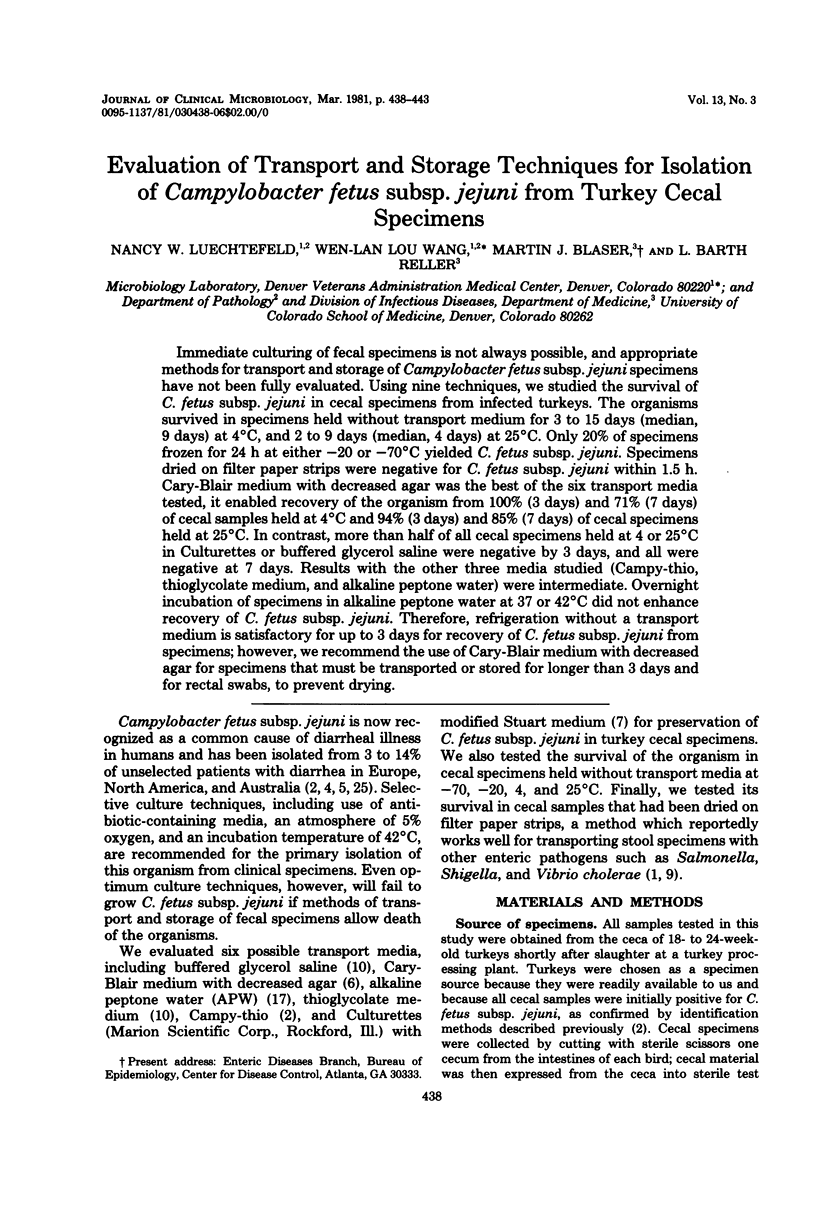
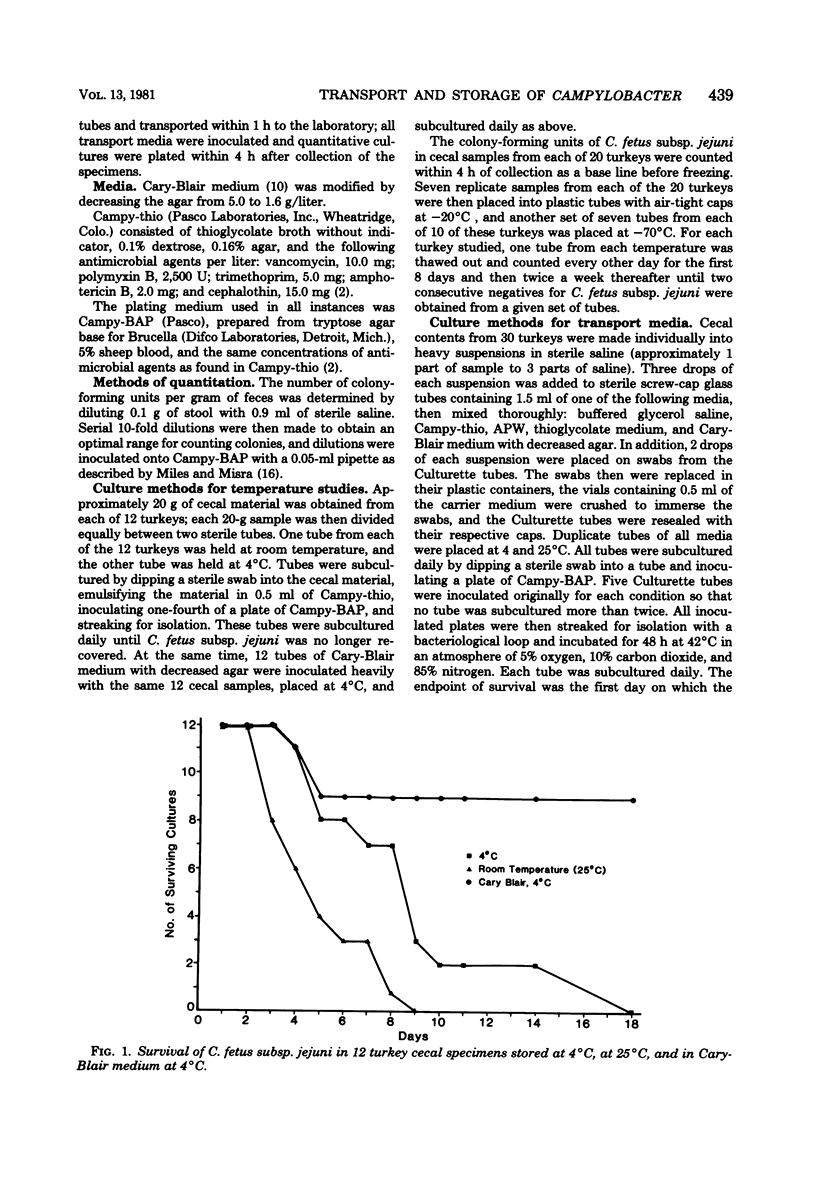
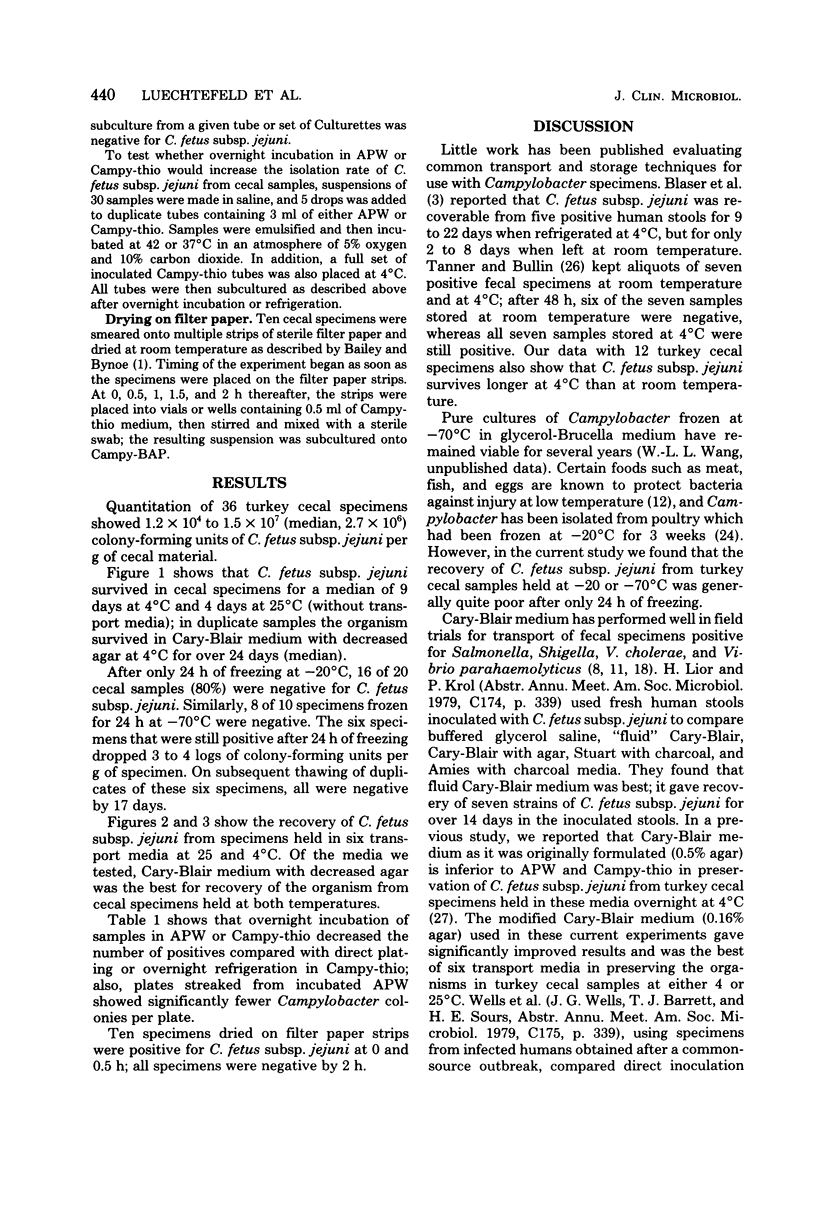
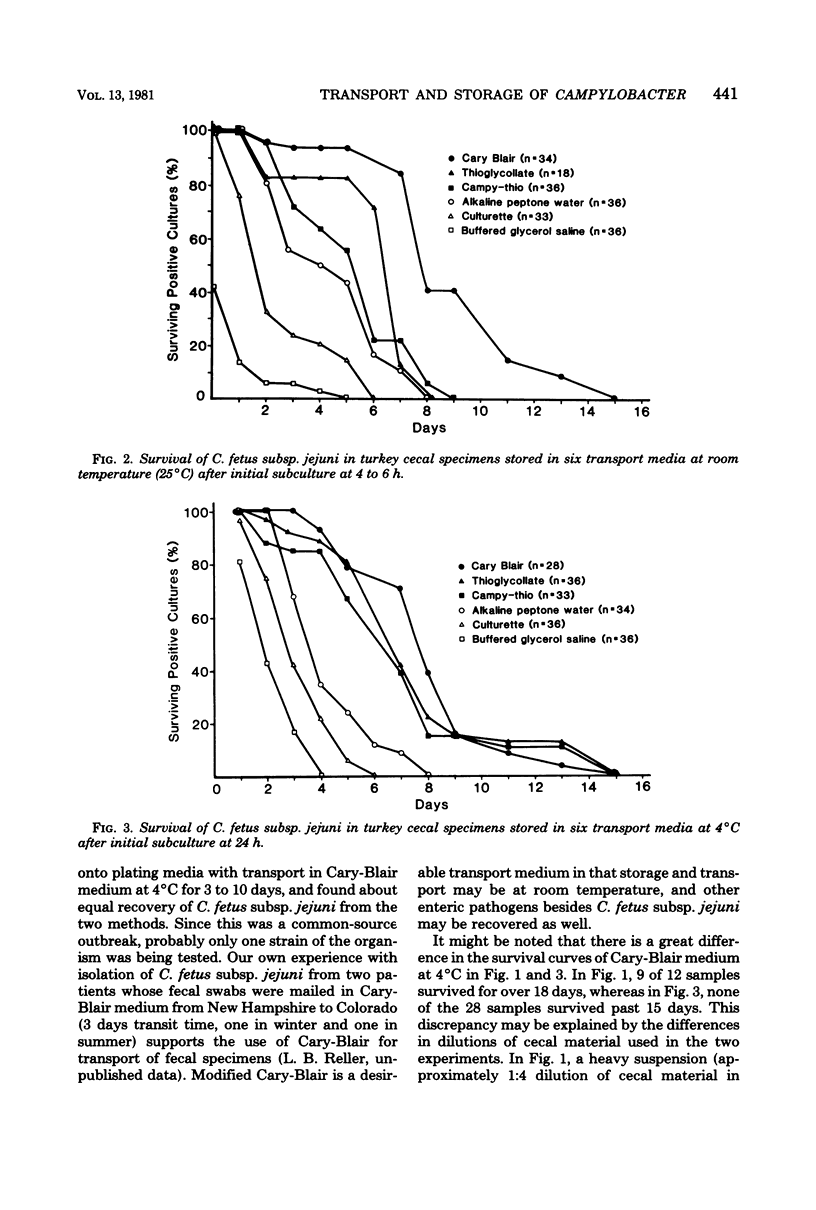
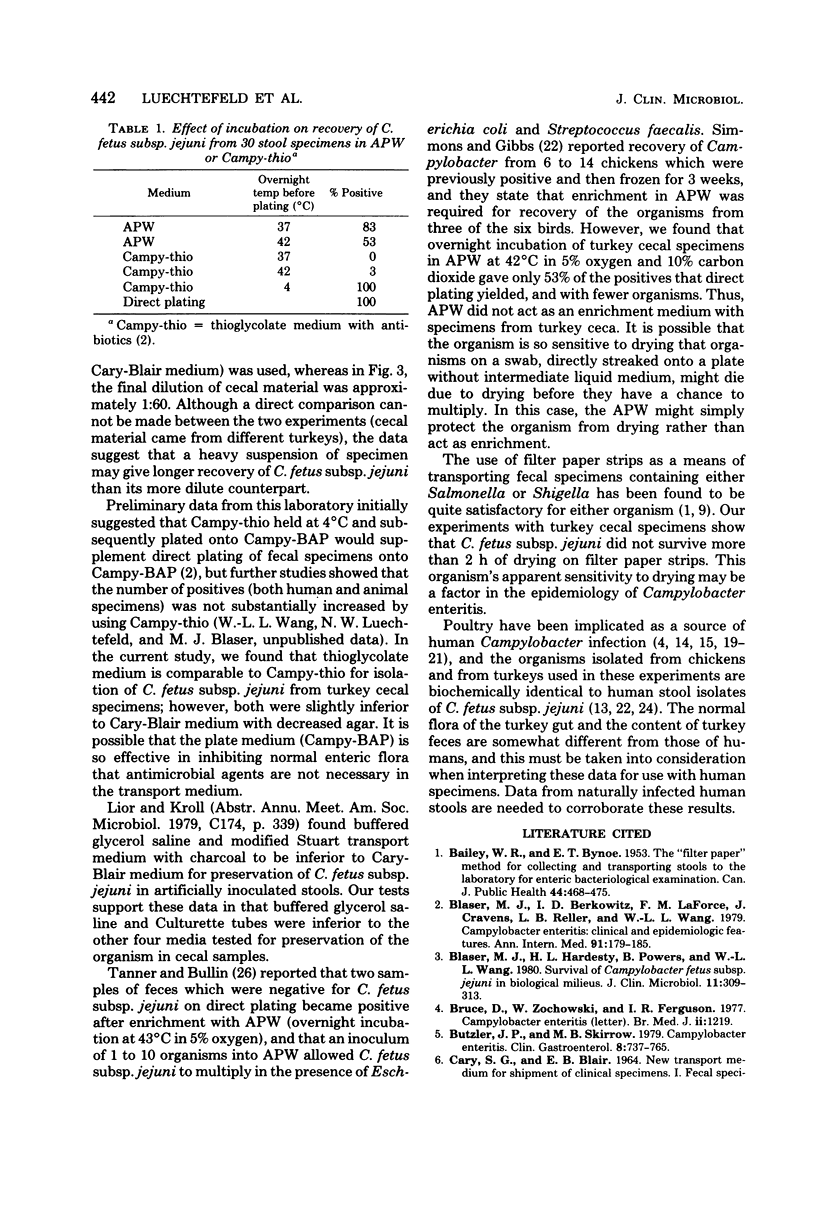
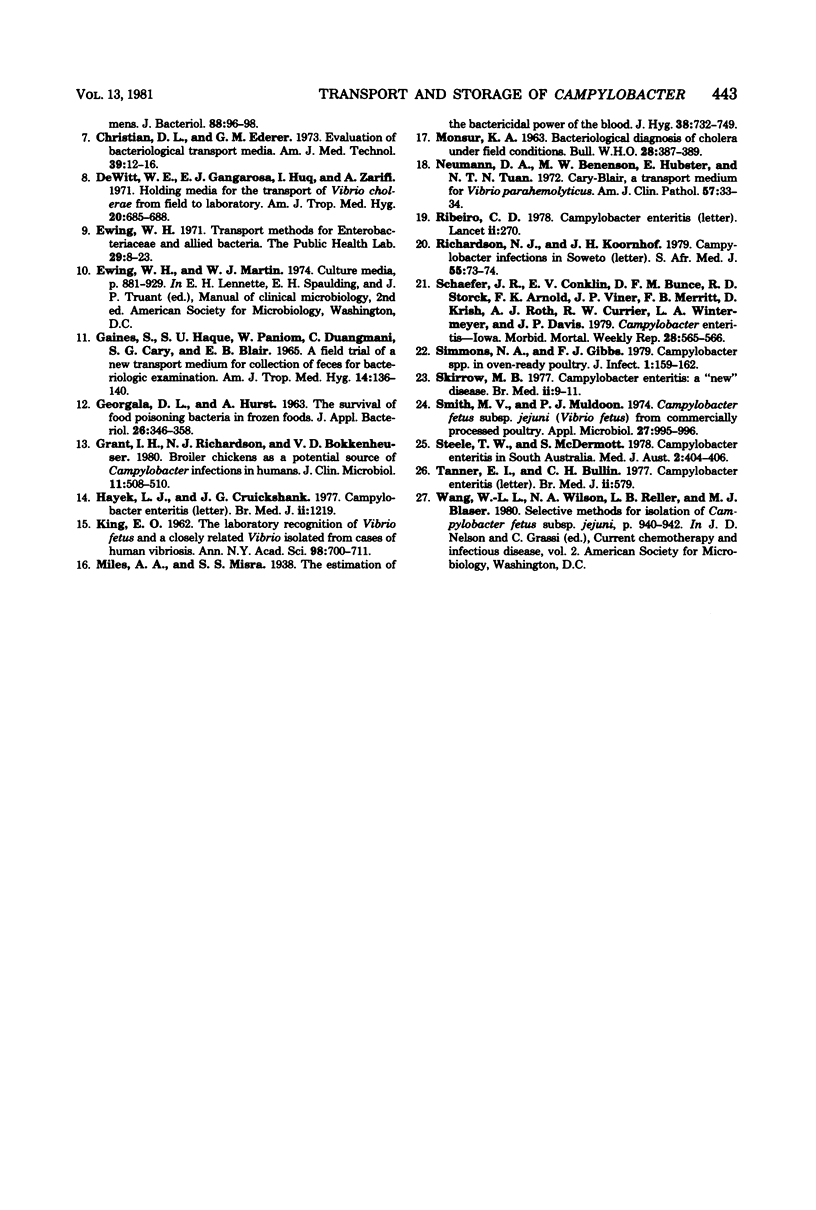
Selected References
These references are in PubMed. This may not be the complete list of references from this article.
- BAILEY W. R., BYNOE E. T. The filter paper method for collecting and transporting stools to the laboratory for enteric bacteriological examination. Can J Public Health. 1953 Dec;44(12):468–475. [PubMed] [Google Scholar]
- Blaser M. J., Berkowitz I. D., LaForce F. M., Cravens J., Reller L. B., Wang W. L. Campylobacter enteritis: clinical and epidemiologic features. Ann Intern Med. 1979 Aug;91(2):179–185. doi: 10.7326/0003-4819-91-2-179. [DOI] [PubMed] [Google Scholar]
- Blaser M. J., Hardesty H. L., Powers B., Wang W. L. Survival of Campylobacter fetus subsp. jejuni in biological milieus. J Clin Microbiol. 1980 Apr;11(4):309–313. doi: 10.1128/jcm.11.4.309-313.1980. [DOI] [PMC free article] [PubMed] [Google Scholar]
- Butzler J. P., Skirrow M. B. Campylobacter enteritis. Clin Gastroenterol. 1979 Sep;8(3):737–765. [PubMed] [Google Scholar]
- CARY S. G., BLAIR E. B. NEW TRANSPORT MEDIUM FOR SHIPMENT OF CLINICAL SPECIMENS. I. FECAL SPECIMENS. J Bacteriol. 1964 Jul;88:96–98. doi: 10.1128/jb.88.1.96-98.1964. [DOI] [PMC free article] [PubMed] [Google Scholar]
- Christian D. L., Ederer G. M. Evaluation of bacteriological transport media. Am J Med Technol. 1973 Jan;39(1):12–16. [PubMed] [Google Scholar]
- DeWitt W. E., Gangarosa E. J., Hug I., Zarifi A. Holding media for the transport of Vibrio cholerae from field to laboratory. Am J Trop Med Hyg. 1971 Sep;20(5):685–688. doi: 10.4269/ajtmh.1971.20.685. [DOI] [PubMed] [Google Scholar]
- GAINES S., ULHAQUE S., PANIOM W., DUANGMANI C., CARY S. G., BLAIR E. B. A FIELD TRIAL OF A NEW TRANSPORT MEDIUM FOR COLLECTION OF FECES FOR BACTERIOLOGIC EXAMINATION. Am J Trop Med Hyg. 1965 Jan;14:136–140. doi: 10.4269/ajtmh.1965.14.136. [DOI] [PubMed] [Google Scholar]
- Grant I. H., Richardson N. J., Bokkenheuser V. D. Broiler chickens as potential source of Campylobacter infections in humans. J Clin Microbiol. 1980 May;11(5):508–510. doi: 10.1128/jcm.11.5.508-510.1980. [DOI] [PMC free article] [PubMed] [Google Scholar]
- Neumann D. A., Benenson M. W., Hubster E., Thi Nhu Tuan N. Cary-Blair, a transport medium for Vibrio parahemolyticus. Am J Clin Pathol. 1972 Jan;57(1):33–34. doi: 10.1093/ajcp/57.1.33. [DOI] [PubMed] [Google Scholar]
- Ribeiro C. D. Campylobacter enteritis. Lancet. 1978 Jul 29;2(8083):270–271. doi: 10.1016/s0140-6736(78)91789-0. [DOI] [PubMed] [Google Scholar]
- Richardson N. J., Koornhof H. J. Campylobacter infections in Soweto. S Afr Med J. 1979 Jan 20;55(3):73–74. [PubMed] [Google Scholar]
- Skirrow M. B. Campylobacter enteritis: a "new" disease. Br Med J. 1977 Jul 2;2(6078):9–11. doi: 10.1136/bmj.2.6078.9. [DOI] [PMC free article] [PubMed] [Google Scholar]
- Smith M. V., 2nd, Muldoon P. J. Campylobacter fetus subspecies jejuni (Vibrio fetus) from commercially processed poultry. Appl Microbiol. 1974 May;27(5):995–996. doi: 10.1128/am.27.5.995-996.1974. [DOI] [PMC free article] [PubMed] [Google Scholar]
- Steele T. W., McDermott S. Campylobacter enteritis in South Australia. Med J Aust. 1978 Oct 21;2(9):404–406. doi: 10.5694/j.1326-5377.1978.tb76814.x. [DOI] [PubMed] [Google Scholar]
- Tanner E. I., Bullin C. H. Campylobacter enteritis. Br Med J. 1977 Aug 27;2(6086):579–579. doi: 10.1136/bmj.2.6086.579-a. [DOI] [PMC free article] [PubMed] [Google Scholar]


